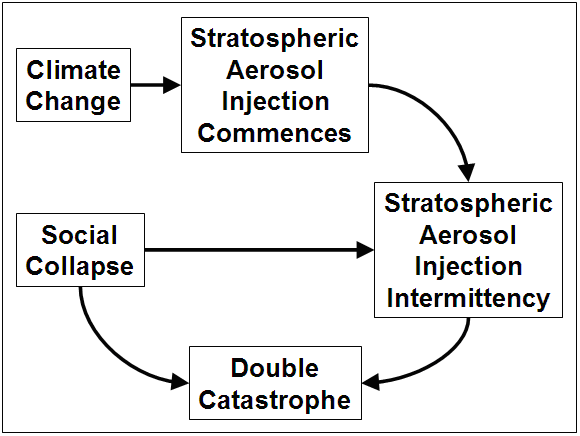
System diagram of the double catastrophe scenario.
A global catastrophe scenario involving climate change, geoengineering, and a separate catastrophe.
Seth D. Baum, Timothy M. Maher, Jr., and Jacob Haqq-Misra, 2013. Double catastrophe: Intermittent stratospheric geoengineering induced by societal collapse. Environment, Systems and Decisions, vol. 33, no. 1 (March), pages 168-180.
Pre-print: Click here to view a full pre-print of the article (pdf).
* Summarized in When global catastrophes collide: The climate engineering double catastrophe, published in Scientific American blogs, reprinted in Yahoo News
* Summary and audio interview at Blue Marble Space Institute of Science
* Discussed at Global Catastrophic Risk Institute, Overcoming Bias, Andrew Sullivan, National Geographic 'Change Reaction', GeoEngineering Watch, Financial Chronicle
Abstract:
Perceived failure to reduce greenhouse gas emissions has prompted interest in avoiding the harms of climate change via geoengineering, that is, the intentional manipulation of Earth system processes. Perhaps, the most promising geoengineering technique is stratospheric aerosol injection (SAI), which reflects incoming solar radiation, thereby lowering surface temperatures. This paper analyzes a scenario in which SAI brings great harm on its own. The scenario is based on the issue of SAI intermittency, in which aerosol injection is halted, sending temperatures rapidly back toward where they would have been without SAI. The rapid temperature increase could be quite damaging, which in turn creates a strong incentive to avoid intermittency. In the scenario, a catastrophic societal collapse eliminates society's ability to continue SAI, despite the incentive. The collapse could be caused by a pandemic, nuclear war, or other global catastrophe. The ensuing intermittency hits a population that is already vulnerable from the initial collapse, making for a double catastrophe. While the outcomes of the double catastrophe are difficult to predict, plausible worst-case scenarios include human extinction. The decision to implement SAI is found to depend on whether global catastrophe is more likely from double catastrophe or from climate change alone. The SAI double catastrophe scenario also strengthens arguments for greenhouse gas emissions reductions and against SAI, as well as for building communities that could be self-sufficient during global catastrophes. Finally, the paper demonstrates the value of integrative, systems-based global catastrophic risk analysis.
Non-Technical Summary: pdf version
Background: Global Catastrophic Risk Systems Analysis
Global catastrophic risks are risks of events that would significantly harm or even destroy humanity at the global scale, such as climate change, nuclear war, and pandemics. To date, most research on global catastrophes analyzes one risk at a time. A better approach uses systems analysis to capture the many important interactions between risks. This paper analyzes a global catastrophe scenario involving climate change, geoengineering, and another catastrophe. We call the scenario "double catastrophe".
Climate Change & Stratospheric Geoengineering
The rising temperatures of global climate change pose great risks to humanity and ecosystems. Climate change can be slowed by reducing emissions of greenhouse gases like carbon dioxide and methane. But humanity has been struggling to reduce emissions. One alternative is geoengineering, the intentional manipulation of Earth systems. The most promising geoengineering option may be stratospheric geoengineering, in which aerosol particles are put into the stratosphere. The particles block sunlight, lowering temperatures on Earth's surface.
Intermittency & Double Catastrophe
One problem with stratospheric geoengineering, known as intermittency, is that the particles must be continuously replaced in the stratosphere. If they're not, then in a few years they fall out, and temperatures rapidly rise back to where they would have been without the geoengineering. The rapid temperature increase would be very damaging to society. Because of this, society is unlikely to let intermittency occur - unless some other catastrophe occurs, knocking out society's ability to continue the geoengineering. Then, the rapid temperature increase hits a population already vulnerable from the initial catastrophe. This double catastrophe could be a major global catastrophe.
Implications For Decision Making
Because of how damaging global catastrophes would be to human civilization, decision making is often oriented towards minimizing the risk of global catastrophe. Stratospheric geoengineering can prevent global catastrophe from climate change alone, but it can also lead to global catastrophe from the double catastrophe scenario. If global catastrophe is more likely from climate change alone, then society should decide to implement stratospheric geoengineering. Otherwise, society is better off without stratospheric geoengineering. This assumes (among other things) that the goal should be minimizing global catastrophic risk and that stratospheric geoengineering is the best form of geoengineering.

System diagram of the double catastrophe scenario.
Created 4 Jan 2013 * Updated 27 Jul 2015